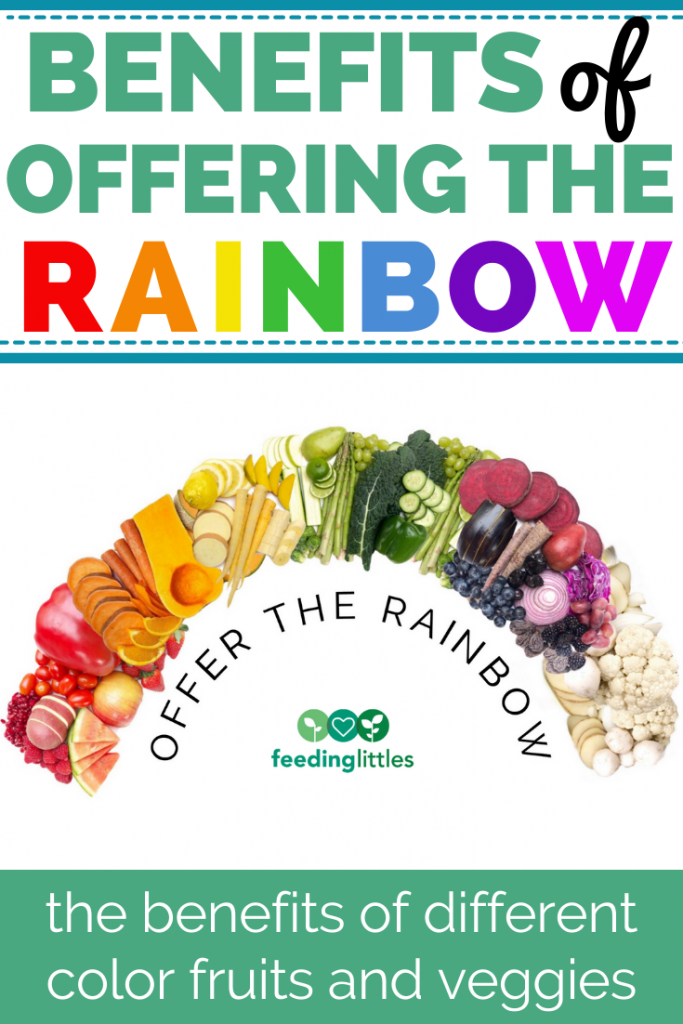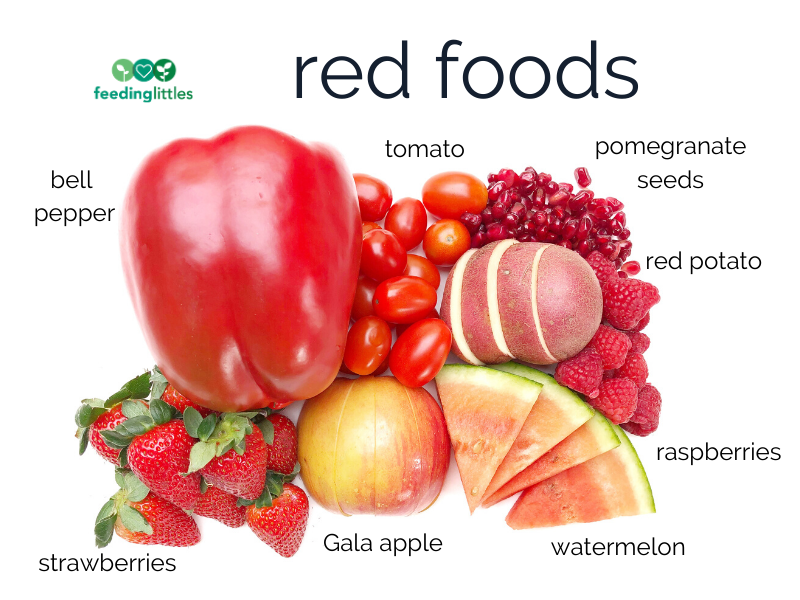We hear that we should eat a “rainbow of color” in our food every day, but what does this mean? Why? We wanted to share some of the benefits of each color of veggies/fruits with you and teach you how to serve them safely to your baby, toddler or child. Check out our free printable for serving suggestions of all colors!

In case you haven’t tried to categorize veggies or fruits into color, it can actually be kind of hard! Some are red on the outside but white on the inside, others are kinda red, kinda purple, etc. The point is that we want to aim for lots of color and lots of variety in the foods we’re eating. Different colors = different nutrients.
Some foods are more or less available given the season, which is why it’s great to focus on seasonal produce when it’s available. You’ll get more variety over the course of the year that way.
Remember that our online Infant and Toddler & Kid Courses contain shopping lists that help you maneuver the grocery store!

Red Foods
Why red? Red produce oftentimes contains vitamins A and C, folate, and phytonutrients lycopene and quercetin, important for heart health and immune system function. If your toddler is on a color kick, ask them to identify the red foods on their plate. Perhaps they can write out the number 2 in red foods.
Note: pomegranate seeds are kind of a weird in-between food, safety-wise. If serving whole make sure your toddler is chewing and not swallowing them whole.

Orange Foods
Why offer orange foods (besides the fact that they’re delicious)? The major benefit of orange (and even red) foods is beta carotene, a precursor to vitamin A. Don’t worry – you can’t overdose on vitamin A by eating a diet that’s high in beta carotene, as your body only converts from beta carotene to vitamin A what it needs. Vitamin A is really important for our immune system, as well as eye, vision, skin, and mucous membrane health.
Fun fact: if you eat a lot of carrots or other orange foods high in beta carotene, you can turn your skin yellow/orange. This usually appears on the palms and soles and isn’t dangerous – it usually happens if consuming lots of carrots or similar foods in concentrated forms (like juicing them daily).

Yellow Foods
What are the benefits of yellow foods? Yellow veggies and fruits contain carotenoids and bioflavonoids (which help the body use vitamin C). They’re also great sources of vitamin C, minerals and other phytonutrients which may prevent disease.

Green Foods
You’ve probably heard the term “eat your greens,” but why are green veggies and fruits important? They’re great sources of vitamins A and C, potassium and folate. Additionally, they’re packed with phytonutrients that may help prevent disease and plenty of fiber. Green produce may help support your immune system, help reduce your risk of cancer and diabetes, and help build bone mass.
Leafy greens may be hard for young children to chew. If you serve green leafy veggies, make sure your child already has a good rotary chew pattern {at least 14-16 months} and you’re serving the crunchy part of the lettuce. Otherwise, cooking into other foods like eggs or pasta dishes may be an easier way for babies and toddlers to eat green leafies.

Blue/Purple Foods
What are the benefits of purple and blue veggies and fruits? (Oh, and some dark red ones that snuck in here?) Blue and purple produce contain anthocyanins, a phytonutrient that may reduce inflammation. According to the USDA, purples {aka red} cabbage has 6-8 times more vitamin C than green cabbage.
Note: We managed to forget about eggplant – it’s so good sautéed in olive oil with tons of garlic! As strips for babies or strips/diced for toddlers!

White/Beige Foods
Why in the world would we focus on white or beige foods? Don’t we want to eat more colorful options? Friends, there are many beneficial white/beige veggies and fruits out there – these are just a few choices too! Foods like onion, leek and garlic are packed with antioxidants, which help protect your cells against oxidative stress, and certain vitamins and minerals. They may be helpful in heart disease prevention. Cauliflower is a cruciferous veggie that may have anti-cancer benefits. Mushrooms are high in selenium {another antioxidant} and B vitamins and are heavily studied for their medicinal disease preventive qualities. Poor white potato, often seen as “void of nutrition,” is actually a great source of vitamin C and fiber.
Furthermore, all foods provide benefit and nutrition – yes, even those white starches!
When you look at our serving suggestions on our free printable, you’ll see that we divided it into categories (babies and toddlers). Once babies have a pincer grasp they can pick up smaller pieces of foods. The pincer grasp usually doesn’t refine until 10-12 months. These suggestions are simply a few ways – but not all of the ways – you can serve these foods.